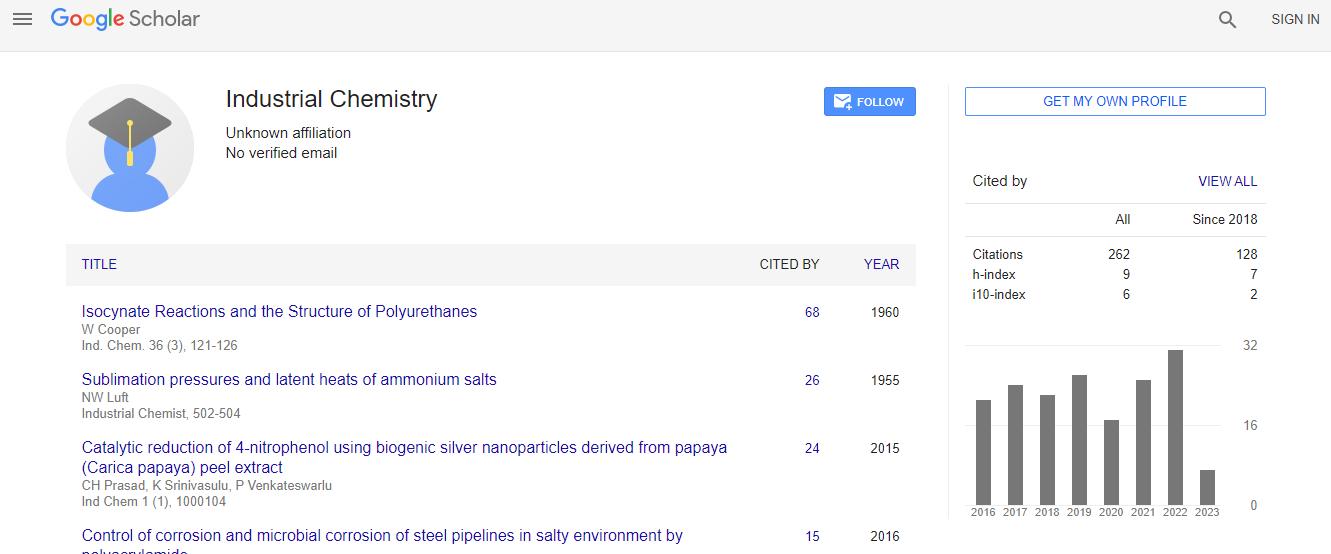Our Group organises 3000+ Global Conferenceseries Events every year across USA, Europe & Asia with support from 1000 more scientific Societies and Publishes 700+ Open Access Journals which contains over 50000 eminent personalities, reputed scientists as editorial board members.
Open Access Journals gaining more Readers and Citations
700 Journals and 15,000,000 Readers Each Journal is getting 25,000+ Readers
Google Scholar citation report
Citations : 262
Industrial Chemistry received 262 citations as per Google Scholar report
Indexed In
- Index Copernicus
- Google Scholar
- RefSeek
- Directory of Research Journal Indexing (DRJI)
- Hamdard University
- EBSCO A-Z
- OCLC- WorldCat
- Scholarsteer
- Geneva Foundation for Medical Education and Research
- Euro Pub
Useful Links
Recommended Journals
Related Subjects
Share This Page
Application of singlet oxygen generated in heterogeneous systems in various oxidation reactions
International Conference on Industrial Chemistry
Katarzyna Piwowar and Jerzy K Zak
Silesian University of Technology, Poland
ScientificTracks Abstracts: Ind Chem
Abstract
Photoexcitation of atmospheric oxygen by several photosensitizers leads to generation of singlet oxygen molecule having exceptionally high oxidation potential. Due to its millisecond lifetime a continuous, in situ generation is required in the environment in which it is reacting. This strategy is a case of green technology which employs sunlight energy to improve the efficiency of many processes, especially in organic synthesis or wastewater treatment. Novel heterogeneous systems generating singlet oxygen seem to be a perspective option for an application of singlet oxygen oxidation capacity. These systems involve two phases with the active interface. The first phase consist a photosensitizer, which is responsible for singlet oxygen generation, and the second holds the species being oxidized. The photoactive phase should combine an effective solar radiation absorption and the direct energy conversion together with a high photostability, whereas the second accumulates the oxidized product. We report on oxidation of organic model compounds like phenol, citronellol or �±-terpinen in two types of heterogeneous systems, first, with a solid material as an active phase, and second with a liquid solution. Photo-active material was prepared by simple electrochemical method using electropolymerization of well-known photosensitizers - phenothiazines. The liquidliquid phase contain the liquid active phase in which the photosensitizers are dissolved in common organic solvents or in ionic liquids. Under visible light illumination these heterogeneous systems were able to generate singlet oxygen directly to the interface with the second phase where it was employed in the oxidation process. The effectiveness of the process was monitored by UVV is spectroscopy and the activation was achieved by diode laser with the excitation wavelength at 638 nm.Biography
Katarzyna Piwowar has completed her Master degree from Silesian University of Technology (SiUT), Faculty of Chemistry with the degree in Analytical Chemistry. She has been doing her PhD at Department of Physical Chemistry and Technology of Polymers, SiUT. Her research concerns the investigation of effectiveness of singlet oxygen generation activated by light illumination in heterogeneous systems, and the application of this highly reactive species. She has published 5 papers in reputed journals (Σ IF= 18,444). Currently, she is involved as the project executive in two UE projects, and as the project manager of her individual project supported by Polish National Science Center.
Email: Katarzyna.Piwowar@polsl.pl

 Spanish
Spanish  Chinese
Chinese  Russian
Russian  German
German  French
French  Japanese
Japanese  Portuguese
Portuguese  Hindi
Hindi 